Slynurse
On this page, you find all documents, package deals, and flashcards offered by seller Slynurse.
- 207
- 0
- 7
Community
- Followers
- Following
214 items

American Red Cross-ACLS-Final Exam Questions with Accurate Answers
A patient is in cardiac arrest. The cardiac monitor shows asystole. In addition to providing continuous high-quality CPR, what is the other priority intervention for this patient? - ANSWER-Administering epinephrine as early as possible A patient has experienced return of spontaneous circulation (ROSC) after cardiac arrest. The healthcare team is conducting a secondary assessment to determine the possible cause of the patient's cardiac arrest. Before the arrest, the patient exhibited jugular...
- Package deal
- Exam (elaborations)
- • 7 pages •
A patient is in cardiac arrest. The cardiac monitor shows asystole. In addition to providing continuous high-quality CPR, what is the other priority intervention for this patient? - ANSWER-Administering epinephrine as early as possible A patient has experienced return of spontaneous circulation (ROSC) after cardiac arrest. The healthcare team is conducting a secondary assessment to determine the possible cause of the patient's cardiac arrest. Before the arrest, the patient exhibited jugular...
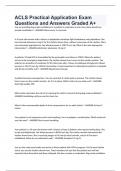
ACLS Practical Application Exam Questions and Answers Graded A+
You are providing bag-mask ventilations to a patient in respiratory arrest. How often should you provide ventilations? - ANSWER-About every 5-6 seconds A 45-year-old woman with a history of palpitations develops light headedness and palpitations. She has recieved adenosine 6 mg IV for the rhythm shown here, without conversion of the rhythm. She is now extremely apprehensive. Her blood pressure is 128/70 mm Hg. What is the next appropriate intervention? - ANSWER-Administer adenosine 12 mg IV ...
- Package deal
- Exam (elaborations)
- • 3 pages •
You are providing bag-mask ventilations to a patient in respiratory arrest. How often should you provide ventilations? - ANSWER-About every 5-6 seconds A 45-year-old woman with a history of palpitations develops light headedness and palpitations. She has recieved adenosine 6 mg IV for the rhythm shown here, without conversion of the rhythm. She is now extremely apprehensive. Her blood pressure is 128/70 mm Hg. What is the next appropriate intervention? - ANSWER-Administer adenosine 12 mg IV ...
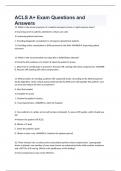
ACLS A+ Exam Questions and Answers
12. Which is the primary purpose of a medical emergency team or rapid response team? A Improving care for patients admitted to critical care units B. Improving patient outcomes C. Providing diagnostic consultation to emergency department patients D. Providing online consultation to EMS personnel in the field -ANSWER-B. Improving patient outcomes 13. Which is the recommended next step after a defibrillation attempt? A Check the ECG evidence of a rhythm B. Open the patient's airway ...
- Package deal
- Exam (elaborations)
- • 9 pages •
12. Which is the primary purpose of a medical emergency team or rapid response team? A Improving care for patients admitted to critical care units B. Improving patient outcomes C. Providing diagnostic consultation to emergency department patients D. Providing online consultation to EMS personnel in the field -ANSWER-B. Improving patient outcomes 13. Which is the recommended next step after a defibrillation attempt? A Check the ECG evidence of a rhythm B. Open the patient's airway ...
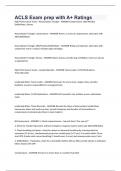
ACLS Exam prep with A+ Ratings
High Performance Teams - Resuscitation Triangle - ANSWER-Compressions, AED/Monitor Defibrillator, Airway Resuscitation Triangle: Compressions - ANSWER-Assess, 5 cycles of compressions, alternates with AED/defibrillator Resuscitation Triangle: AED/Monitor/Defibrillator - ANSWER-Brings and operates, alternates with compressor every 5 cycles/2 minutes/signs of fatigue Resuscitation Triangle: Airway - ANSWER-Opens airway, provides bag ventilation, inserts an airway as appropriate High P...
- Package deal
- Exam (elaborations)
- • 2 pages •
High Performance Teams - Resuscitation Triangle - ANSWER-Compressions, AED/Monitor Defibrillator, Airway Resuscitation Triangle: Compressions - ANSWER-Assess, 5 cycles of compressions, alternates with AED/defibrillator Resuscitation Triangle: AED/Monitor/Defibrillator - ANSWER-Brings and operates, alternates with compressor every 5 cycles/2 minutes/signs of fatigue Resuscitation Triangle: Airway - ANSWER-Opens airway, provides bag ventilation, inserts an airway as appropriate High P...
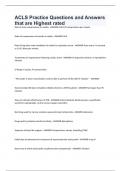
ACLS Practice Questions and Answers that are Highest rated
Rate of chest compressions for adults - ANSWER-100-120 compressions per minute Ratio of compressions to breaths in adults - ANSWER-30:2 Rate of bag valve mask ventilation for adults in respiratory arrest - ANSWER-Once every 5-6 seconds or 10-12 times per minute Treatments for hypotension following cardiac arrest - ANSWER-IV dopamine infusion, IV epinephrine infusion IV Ringer's lactate, IV normal saline *The leader in team resuscitation must be able to perform all the skills if ...
- Package deal
- Exam (elaborations)
- • 7 pages •
Rate of chest compressions for adults - ANSWER-100-120 compressions per minute Ratio of compressions to breaths in adults - ANSWER-30:2 Rate of bag valve mask ventilation for adults in respiratory arrest - ANSWER-Once every 5-6 seconds or 10-12 times per minute Treatments for hypotension following cardiac arrest - ANSWER-IV dopamine infusion, IV epinephrine infusion IV Ringer's lactate, IV normal saline *The leader in team resuscitation must be able to perform all the skills if ...
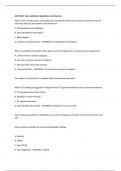
ACLS 2021 Top rated Exam Questions and Answers
Which class of medications commonly given to patients with acute coronary syndromes may be adversely affected by morphine administration A. Phosphodiesterase inhibitors B. Oral antiplatelet medications C. Beta blockers D. Calcium channel blockers - ANSWER-Oral antiplatelet medications What is a benefit of morphine when given for the management of acute coronary syndromes? A. Central nervous system analgesia B. Increases systemic vascular resistance C. Increases left ventricular preload...
- Package deal
- Exam (elaborations)
- • 20 pages •
Which class of medications commonly given to patients with acute coronary syndromes may be adversely affected by morphine administration A. Phosphodiesterase inhibitors B. Oral antiplatelet medications C. Beta blockers D. Calcium channel blockers - ANSWER-Oral antiplatelet medications What is a benefit of morphine when given for the management of acute coronary syndromes? A. Central nervous system analgesia B. Increases systemic vascular resistance C. Increases left ventricular preload...
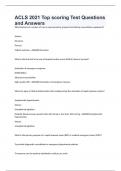
ACLS 2021 Top scoring Test Questions and Answers
What element of a system of care is represented by properly functioning resuscitation equipment? System Structure Process Patient outcome - ANSWER-Structure What is the first link in the out-of-hospital cardiac arrest (OHCA) chain of survival? Activation of emergency response Defibrillation Advanced resuscitation High-quality CPR - ANSWER-Activation of emergency reponse What are signs of clinical deterioration that would prompt the activation of rapid response system? Sym...
- Package deal
- Exam (elaborations)
- • 41 pages •
What element of a system of care is represented by properly functioning resuscitation equipment? System Structure Process Patient outcome - ANSWER-Structure What is the first link in the out-of-hospital cardiac arrest (OHCA) chain of survival? Activation of emergency response Defibrillation Advanced resuscitation High-quality CPR - ANSWER-Activation of emergency reponse What are signs of clinical deterioration that would prompt the activation of rapid response system? Sym...
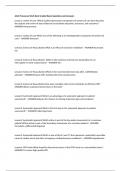
ACLS Precourse Work Best Graded Exam Questions and Answers
Lesson1: system of care. Which quality improvement component of systems of care best describes the capture and review of data related to resuscitation education, processes, and outcomes? - ANSWER-Measurement Lesson1: system of care.Which one of the following is an interdependent component of systems of care? - ANSWER-Structure Lesson2: Science of Resuscitation.What is an effect of excessive ventilation? - ANSWER-decreased CO Lesson2: Science of Resuscitation. Which is the maximum inter...
- Package deal
- Exam (elaborations)
- • 5 pages •
Lesson1: system of care. Which quality improvement component of systems of care best describes the capture and review of data related to resuscitation education, processes, and outcomes? - ANSWER-Measurement Lesson1: system of care.Which one of the following is an interdependent component of systems of care? - ANSWER-Structure Lesson2: Science of Resuscitation.What is an effect of excessive ventilation? - ANSWER-decreased CO Lesson2: Science of Resuscitation. Which is the maximum inter...
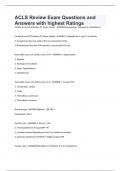
ACLS Review Exam Questions and Answers with highest Ratings
Cardiac Arrest VF/Pulseless VT drugs--names - ANSWER-Epinephrine, Vasopressin, Amiodarone Cardiac Arrest VF/Pulseless VT drugs--details - ANSWER-1. Epinephrine 1 mg Q 3-5 minutes 2. Vasopressin 40 U can replace first or second dose of Epi 3. Amiodarone: first dose 300 mg bolus, second dose 150 mg Reversible causes of cardiac arrest: 5 Hs - ANSWER-1. Hypovolemia 2. Hypoxia 3. Hydrogen ion/acidosis 4. Hypo-/hyperkalemia 5. Hypothermia Reversible causes of cardiac arrest: 5 Ts - AN...
- Package deal
- Exam (elaborations)
- • 7 pages •
Cardiac Arrest VF/Pulseless VT drugs--names - ANSWER-Epinephrine, Vasopressin, Amiodarone Cardiac Arrest VF/Pulseless VT drugs--details - ANSWER-1. Epinephrine 1 mg Q 3-5 minutes 2. Vasopressin 40 U can replace first or second dose of Epi 3. Amiodarone: first dose 300 mg bolus, second dose 150 mg Reversible causes of cardiac arrest: 5 Hs - ANSWER-1. Hypovolemia 2. Hypoxia 3. Hydrogen ion/acidosis 4. Hypo-/hyperkalemia 5. Hypothermia Reversible causes of cardiac arrest: 5 Ts - AN...

ACLS Premium Exam Questions and Answers
Your patient is in cardiac arrest and has been intubated. to assess CPR quality, what should you do? - ANSWER-monitor the patients PETCO2 Which facility is the most appropriate EMS destination for a patient with sudden Cardiac Arrest who achieved return of spontaneous circulation in the field? - ANSWER-coronary reperfusion capable Medical Center what sign is a likely indicator of cardiac arrest in an unresponsive patient? - ANSWER-agonal gasps To properly ventilate a patient with a rep...
- Package deal
- Exam (elaborations)
- • 4 pages •
Your patient is in cardiac arrest and has been intubated. to assess CPR quality, what should you do? - ANSWER-monitor the patients PETCO2 Which facility is the most appropriate EMS destination for a patient with sudden Cardiac Arrest who achieved return of spontaneous circulation in the field? - ANSWER-coronary reperfusion capable Medical Center what sign is a likely indicator of cardiac arrest in an unresponsive patient? - ANSWER-agonal gasps To properly ventilate a patient with a rep...
